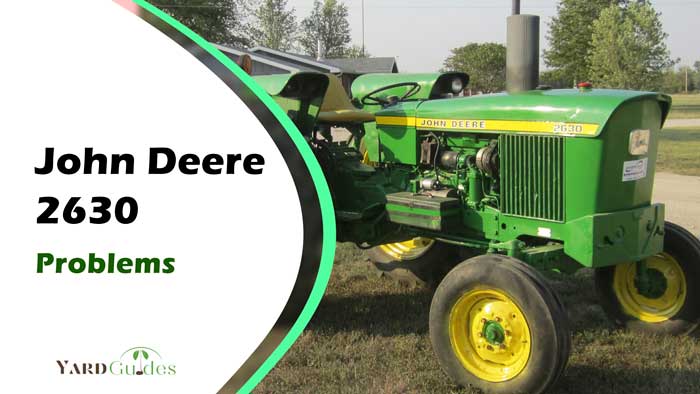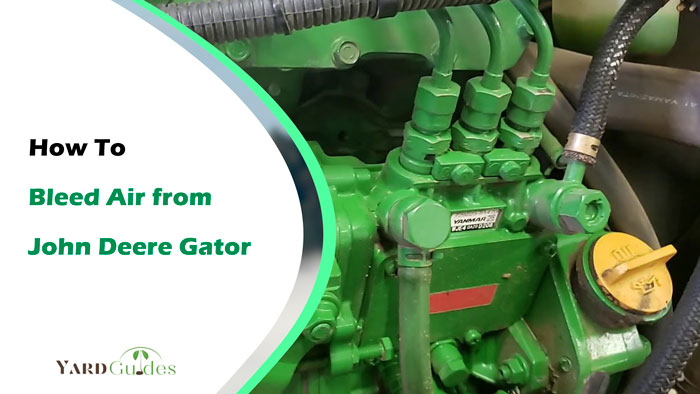The John Deere 2630 is a well-liked agricultural tractor renowned for its versatility and durability. All these make it a favorite option among farmers and agricultural workers. But like other machines, it also encounters some issues which should be addressed and fixed.
Typical John Deere problems include a bad battery, a malfunctioning fuel system, a hydraulic system, a damaged braking system, and engine and transmission issues.
You can use the information in this article to become aware of the common problems you might face with your John Deere 2630 tractor. Also, we will discuss how to fix them.
John Deere 2630 Problems And Their Fixes
Following are the problems and their solutions, listed in the table below for a quick overview.
| Problems | Solutions |
| Loose battery connections | Tighten any loose battery cables with a wrench or pliers. |
| Overcharging | Replace the voltage regulators. |
| Jammed fuel filter | If your fuel filter is clogged, replace it. |
| Damaged hydraulic cylinder | Maintain appropriate fuel levels and replace broken seals/pistons. |
| Punctured hydraulic hoses | Repair the puncture in the hose. |
| Rusted brake calipers | Clean and grease the calipers. |
| Leaks in the brake valve | Replace the component causing the leak. |
| Overheating | Check the coolant level and keep the radiator clean. |
| Difficulty starting the engine | Check the battery voltage and replace the battery if it is dead. |
| Transmission fluid leaks | Replace the component causing the leak. |
Common Problems Found In John Deere 2630:
The major problems that affect John Deere 2630 tractors are described below-
1. A Bad Battery:
Long-term use and overload can damage or drain your tractor’s battery, which might cause electrical problems or ignition troubles. A faulty battery may be the result of overcharging and loose battery connections.
Problem 1: Loose battery connections–
If rust builds up on the battery terminals, it can cause a weak connection between the battery and the tractor. Also, if you regularly use the tractor, the vibration of the tractor can cause loose battery terminals.
Symptoms
Loose battery connections can cause symptoms like-
- Dimming headlights
- Warning signs flashing on the dashboard
- Difficulty starting the engine.
Solution
First, remove the negative and positive cables from the battery to disconnect it. Next, check the battery terminals for corrosion. Then use a wrench or pliers to tighten the battery connections and cable ends.
Problem 2: Overcharging-
When the voltage regulator is broken, the battery may be charged more rapidly, which might result in overcharging.
Symptoms
An overcharged battery will show the signs listed below:
- The battery could appear enlarged.
- The surface of the battery will become excessively hot.
Solution
Replace the tractor’s faulty voltage regulator and you should do routine maintenance on the tractor’s charging system.
2. A Malfunctioning Fuel System
A faulty fuel system can cause your tractor to start performing poorly. A fuel system failure is mainly caused by a clogged fuel filter. Your vehicle’s fuel filter could eventually become jammed if you use poor fuel in your John Deere 2630 and if dirt builds up inside the fuel filter.
Symptoms
Your John Deere 2630 will show the following symptoms if it has a jammed fuel filter.
- The tractor will use too much fuel.
- Black smoke from the exhaust
- The tractor won’t start.
Solution
You should first inspect the fuel filter located between the fuel tank and the engine. Then, take off the fuel pump fuse to release the pressure in the fuel system. After carefully removing the old fuel filter using a wrench, install the new one.
A properly maintained fuel filter results in a 3.5% power increase. You should change the fuel filter in your John Deere 2630 once every two years.
3. A Faulty Hydraulic System
Your tractor may experience hydraulic system issues such as damaged hydraulic cylinders and punctured hydraulic hoses after prolonged use.
Problem 1: Damaged Hydraulic Cylinders-
The hydraulic cylinder provides a smooth and controlled motion, making it easier for you to operate the tractor. A damaged hydraulic cylinder can be caused by:
- Prolonged use of the hydraulic cylinder without maintenance.
- Exposure to incredibly hot temperatures.
- Using the wrong hydraulic fluid.
Symptoms
A damaged hydraulic cylinder will show the symptoms listed below:
- Hydraulic fluid dripping from the cylinder.
- The hydraulic system will make unusual sounds.
Solution
- If you notice any physical damage like dents or leaks to your hydraulic cylinder, contact a mechanic and get it replaced immediately.
- Inspect the quantity and quality of the hydraulic fluid and add more or replace it as necessary.
Problem 2: Punctured hydraulic hoses-
Hydraulic hoses in John Deere tractors can become punctured due to regular wear and tear, high-pressure fluids, and physical damage.
Symptoms
Hydraulic fluid may leak from a damaged hose, which would decrease the hydraulic power.
Solution
Any punctured hydraulic hose needs to be changed right away if you don’t want the hydraulic fluid to leak and cause further damage to the tractor’s hydraulic system.
4. Damaged Braking System
Your John Deere 2630 tractor may experience a faulty braking system due to poor maintenance, a rusted brake caliper, and leaks in the brake valve.
Problem 1: Rusted Brake Calipers-
The brake calipers control how quickly the tractor can stop or slow down. As a result of the lack of routine maintenance and the buildup of debris in the brake system, these calipers may rust over time.
Symptoms
The symptoms of corroded brake calipers are:
- When brakes are applied, you can hear a squeaking sound.
- The brake pedal keeps vibrating.
- Reduced braking efficiency.
Solution
If you see that the brake caliper has accumulated rust, thoroughly clean it and then lubricate it. To avoid exposure to moisture and external elements, keep the tractor after use in a dry, covered area.
Problem 2: Leaks in the brake valve-
To avoid brake failure, it’s important to keep the brake valves in good condition. Your tractor’s brake valve may leak due to corroded or worn-out seals, damaged valve bodies, or other factors.
Symptoms
Symptoms of leaks in the brake valve include:
- Reduced braking power.
- Unresponsive brake pedal.
Solution
The most common solution for brake valve leaks is to replace the worn-out seals or the whole valve body.
5. Engine Problems
A John Deere 2630 engine can develop a number of issues over time, just like any other vehicle. The most typical engine issues include overheating and difficulty starting the engine.
Problem 1: Overheating-
According to Reference.Com, engine overheating is a common problem with John Deere tractors. The possible reasons that can cause the engine in your tractor may overheat due to low coolant levels or a clogged radiator.
Symptoms
The symptoms of an overheated engine are-
- The engine will start making knocking or beeping noises.
- A warning light will flash on the tractor’s dashboard.
- The coolant may leak from the radiator.
Solutions
Check your engine’s coolant level frequently, and replace any clogged radiators or other components that may be the cause of engine overheating.
Problem 2: Difficulty starting the engine-
If your tractor has a broken ignition switch or a dead battery, you can have trouble starting the engine.
Symptoms
- Gradually, the performance of the engine decreases.
- The engine cranks but does not start.
Solutions
- You should make sure the ignition switch is working properly and replace it if necessary.
- Check the voltage of the battery, and replace the battery right away if it is dead.
6. Transmission Issues
According to studies, an effective transmission system can boost a tractor’s working speed by up to 10%. After a few years of use, the majority of John Deere owners complain about transmission fluid leaks.
A broken filter cap, damaged transmission fluid pipes, or unsecured bolts can all lead to transmission fluid leaks.
Symptoms
The symptoms of transmission fluid leaks include-
- It will be difficult for you to shift gears.
- There will be fluid stains underneath the tractor.
Solutions
Consult a professional and have the filter cap and transmission fluid pipes changed if you notice any damage. Using a wrench, loose bolts can be tightened.
Check out this Youtube video to know more about how to fix transmission oil leaks.
Final Words
In conclusion, if you keep your John Deere 2630 tractor well-maintained and handle it properly, you can extend the lifespan of your John Deere 2630 tractor.
The engine, fuel system, hydraulic system, and transmission system of your tractor can all develop issues if they aren’t regularly inspected and maintained. By being aware of typical problems and how to fix them can help you save money on unnecessary repairs.



